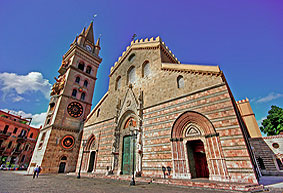


All the structures

Messina, or ‘Missina’ in Sicilian dialect, is located on the west coast of the Strait of Messina. In the eighth century BC it was a Greek colony called Zancle, and a rich and important city in Roman and medieval times. It was badly hit by an earthquake in 1783, and was razed to the ground by another earthquake in 1908, but has since returned to its splendour as an important Sicilian province.
Messina’s old city centre contains visible evidence of its flourishing past, above all medieval. Messina was the birthplace of a major artist, Alessandro da Messina (1430 - 1479), many of whose works are preserved in the Regional Museum of Messina, one of the most noteworthy museums in the region, along with those of Palermo and Syracuse. In these museums you can admire works by Antonello and Michelangelo Merisi, better known as ‘Caravaggio’.
Taormina is one of the most prestigious tourist destinations in Italy. Tauremenion, the oldest, central part of Taormina, stands on a spur of Mount Tauro overlooking the Ionian Sea. The ancient Taormina Theatre, famous throughout Italy, is the second largest in Sicily. Gladiators appeared there in Roman times. From the top of the theatre there is a wonderful view of Etna, and one can see as far as Aspromonte in Calabria.
Messina province is one of the most fortunate in Italy for its many interesting tourist destinations, such as the Aeolian Islands.
The Aeolian or Lipari archipelago offers beautiful scenery and volcanic landscapes. Ulysses tells of the Aeolian Islands in his account of landing on islands dedicated to Aeolus, king of the winds. There are seven Aeolian Islands: Alicusi, Filicudi, Salina, Lipari, Vulcano, Panarea and Stromboli. The highest peak is Mount Fossa delle Felci on Salina, one of the most unspoilt environments in Italy. In 1997 the Aeolian Islands were declared a UNESCO World Heritage Site.